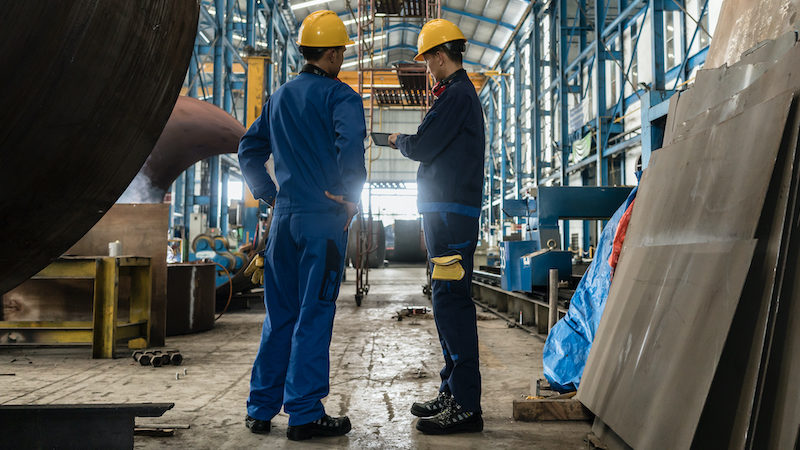
More information sharing and enforcement by OSHA and state agencies could better protect workers from COVID-19.
Workplaces are a significant source of infection for COVID-19, as shown not only by the illnesses of health care workers, but also by the tens of thousands of positive cases and roughly 200 deaths at meatpacking plants. The Occupational Safety and Health Administration (OSHA) has responsibilities for keeping employees safe at work, but it has played a fairly limited role in addressing COVID-19.
Some critics have called for a more aggressive enforcement role from OSHA. I agree that some increase in enforcement, including a new standard for infectious diseases, would be beneficial. But in addition, it is important to improve our ability to identify cases of infection where the workplace is a likely place of transmission. The objective should be to facilitate employers’ and employees’ efforts in identifying infected individuals. In addition to aiding in identifying cases, employers can and should aid in preventing transmission.
Before discussing what role OSHA should play, it bears noting what its role has been to date during the pandemic.
- OSHA does not have a specific standard focused on COVID-19. Organized labor requested that the agency issue an emergency temporary standard, a request that OSHA denied. The U.S. Court of Appeals for the District of Columbia Circuit upheld the agency’s denial.
- OSHA does have standards requiring the use of respirators and other personal protective equipment when workers are exposed to harmful substances. It also has a general duty clause, which requires that employers provide a workplace free of “recognized hazards.”
- The agency has developed guidelines for employers to follow, primarily adapting Centers for Disease Control and Prevention (CDC) guidelines to the particular features of different workplaces.
- From March through August 2020, federal and state occupational safety and health agencies received more than 33,000 COVID-19-related employee complaints. About two-thirds of these complaints had been “closed” by August 30, typically after a letter or phone call to the employer from the agency about the guidelines.
- Federal OSHA—which conducts enforcement in 29 states—has made limited use of enforcement tools, especially in the early months. According to its website, OSHA issued its first COVID-related citations in mid-July for three workplaces and one more in August. In September, OSHA issued citations at a more rapid pace, reaching 85 by October 10. All but two of the firms cited were in the health care industry, where OSHA’s citations centered on violations of personal protective equipment requirements.
- Enforcement has been uneven, with almost two-thirds of the firms cited located in New Jersey or New York. At two large meatpacking plants—which both had hundreds of infected workers and several deaths—OSHA issued citations for violations of its general duty clause. Inspection data reportedly show a total of 43 health inspections of meatpackers by federal and state occupational safety and health programs from March through August, although it is unclear how many focused on COVID-19.
- As I describe below, some of the 21 states with their own occupational safety and health programs have taken further steps to enforce existing regulations.
The most critical task in this pandemic is identifying ill people at an early disease stage, both for their own well-being and for reducing their role in spreading the disease. Although few evaluations of contact tracing for COVID-19 have been published, it appears that these efforts are often frustrated by lack of cooperation from the public. In many cases, employers should be a more reliable source of contact-tracing information. Employers also have their own incentive to prevent employees from spreading disease to fellow workers.
An example of state initiatives that focus on employer reporting is a law enacted in California this summer, which requires employers to notify employees when a worker they interact with has a “potential exposure” to COVID-19. The notification requirement extends to contractors the employer is using and to unions representing the employees. The law also requires the employer to notify the local health department within 48 hours following an outbreak, as defined by the California Department of Public Health.
The notification to a local health department in California must include the names of the individuals who the employer knows have either had positive tests or diagnoses, been told to isolate by a public health official, or died due to COVID-19. The law also requires the state’s public health department to post information about all worksites with positive test results and the number of cases reported. All of these measures appear consistent with Equal Employment Opportunity Commission stipulations. In California, the state’s Division of Occupational Safety and Health enforces these reporting requirements.
All states could adopt similar rules except for the enforcement step. In states with federal occupational safety and health enforcement, states probably cannot assign power to a federal agency to enforce these state rules. Nonetheless, publication of the number of cases reported at each worksite would be valuable for helping federal OSHA target its limited resources, presumably at larger workplaces with more potential to spread infection. Two or three infections at a workplace with 500 workers, however, may indicate much better control efforts than two or three infections at a 20-employee workplace.
Several other steps could be taken.
First, OSHA could share information with state and local health departments about the workplaces where employees had filed complaints. Their additional capacity to investigate could be useful supplements to OSHA’s efforts.
Second, OSHA should change its reporting rules to require employers to report positive employee COVID-19 tests to OSHA within 24 hours. OSHA already requires even quicker employer reporting of deaths, hospitalizations, and amputations. At least at first, we may find significant noncompliance with such a reporting requirement, but it would be one more way to increase the flow of information to identify cases.
Finally, local health departments should be required by state law to report to employers that an employee tested positive for COVID-19. This reporting should occur naturally in the process of contact tracing. To ensure the transfer of information, however, this should be mandated by law. Health Insurance Portability and Accountability Act rules prevent the health department from providing the name of the employee, but employers may require employees to report positive tests.
In the early days of the pandemic, an argument existed for OSHA to use penalties sparingly because of the uncertain information that employers received. Over time, that argument has lost force. U.S. Secretary of Labor Eugene Scalia reportedly observed in April that, “while coronavirus is a hazard in the workplace, it is not caused by work tasks themselves and cannot be viewed in the same regard as other workplace hazards.” It is true that the hazard did not arise from the regular production process. Close contacts at work and other settings, however, can help spread the disease. From a public health perspective, the difference is not germane.
The argument about whether a more punitive approach would be more effective in preventing the spread of disease is more complicated. OSHA currently adheres to a long-standing principle that penalties should accompany the “first instance” of a violation and not be reserved only for employers who fail to come into compliance after being cited. This current practice probably serves a deterrent function, although the size of that precise effect has been difficult to determine.
Nevertheless, OSHA’s current experience with the handful of violations it has cited in COVID-19 inspections suggests that enforcement actions may impose major burdens on the agency itself. Both of the general duty violations it issued against large meatpacking firms have been challenged and will probably take many months to resolve. OSHA probably faces a major hurdle demonstrating what steps firms can feasibly take to reconfigure workplaces to allow distancing between employees. In contrast, requirements for mask wearing should be easier to enforce.
In the long term, it would be useful for OSHA to have a standard that makes it easier to enforce protections against infectious diseases. In the short term, however, it makes sense to focus on spreading information as widely as possible about where infections are occurring.
Policymakers should also not forget other policies that offer protection to employees. These include allowing high-risk, unemployed workers to turn down jobs at workplaces that they do not view as safe but still maintain their benefits. Policies providing coverage under workers’ compensation for COVID-19 cases for diseases likely to be contracted at work could also provide incentives to employers and help for employees, especially those with poor benefits from their employers.



